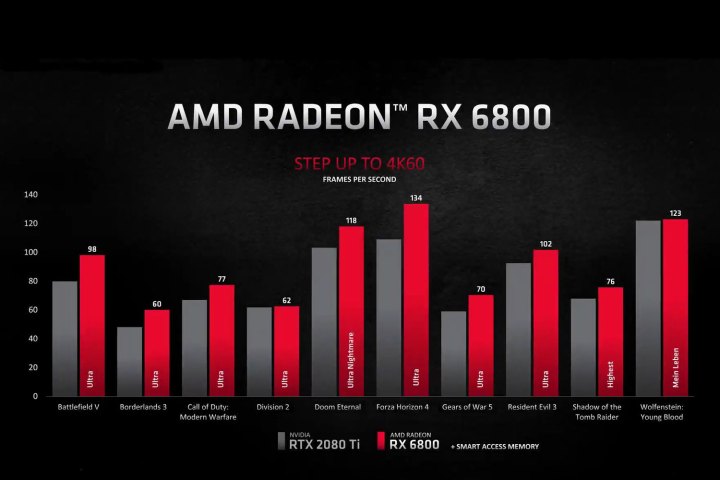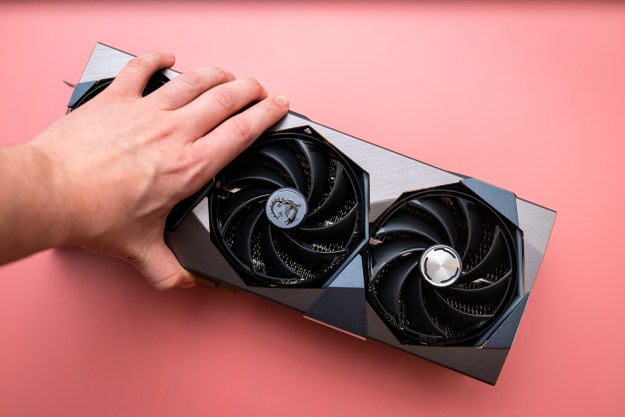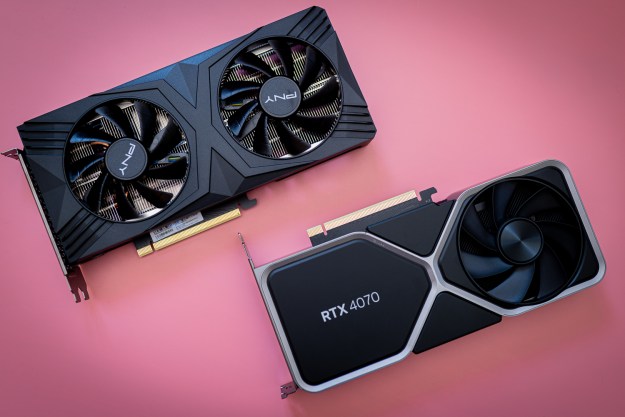AMD’s RDNA 2 graphics cards are the most impressive it’s made in years. They compete with Nvidia’s best in price and performance, and offer real-time ray tracing support for the first time on AMD hardware. Aside from the issues with actually getting ahold of one of these cards, they’re a great option if you’re looking to upgrade your graphics card. But which one offers the best value for the money?
Whether you’re targeting high frame rate 1440p gaming or need something that will make your PC 4K-ready, let’s take a look at how the top AMD RX 6000 GPUs compare to find the best one for you.
Pricing and availability

AMD launched the RX 6800 XT and 6800 graphics cards on November 18, 2020, with launch prices of $649 and $579, respectively. They swiftly flew off the shelves due to the conglomerate issues of global silicon shortages, cryptocurrency miners buying up any GPUs they can find, and gamers being genuinely excited about the new-generation performance. Since then, prices have soared at both retailers and on secondhand markets, whereby you can expect to spend upwards of $800 on either card if buying new or well over $1,000 if buying on eBay or in classified ads.
Similar problems awaited the 6900 XT, which launched on December 8 for $1,000. In early 2021, it is just as hard to find either of the 6800 cards, regularly selling for upwards of $1,500 at retail or over $2,000 on eBay.
With that in mind, the RX 6700 XT faces a troubling launch when it goes on sale on March 18. AMD reference cards will sell for $479, with third-party cards likely to sell for $500 to $600, depending on clock speeds and cooling configurations, but how long that will last remains unclear. There are strong rumors that stock of the 6700 XT will be extremely limited at launch, with some major market countries receiving just several hundred of them on launch day. That will only exacerbate problems with price gouging and scalping, though AMD has pledged to release its reference cards in batches to try to help gamers get their hands on the card at a reasonable price.
Performance
The RX 6700 XT, 6800 XT, and 6900 XT are all tiered GPUs, so real-world performance will very much flow upwards in the same direction as price. How that translates to bang for your buck, though, is an important consideration. The 6900 XT and 6800 XT are relatively well-known properties at this point, where the 6700 XT’s capabilities can only be surmised from AMD’s first-party benchmarks. Those do typically prove quite accurate, but they will have some inherent bias, so it’s important to wait for third-party reviews and test results before drawing a concrete conclusion.

That said, we can take a look at the existing performance numbers and specifications to speculate about what the new card will be capable of and how it will compare with its more expensive RDNA 2 cousins.
| RX 6700 XT | RX 6800 XT | RX 6900 XT | |
| GPU | Navi 22 | Navi 21 | Navi 21 |
| Interface | PCI Express 4.0 | PCI Express 4.0 | PCI Express 4.0 |
| GPU cores | 2,560 stream processors | 4,608 stream processors | 5,120 stream processors |
| Ray tracing cores | 40 | 72 | 80 |
| Base clock | 2,321 MHz | 1,825 MHz | 1,825 MHz |
| Game clock | 2,424 MHz | 2,015 MHz | 2,015 MHz |
| Boost clock | 2,581 MHz | 2,250MHz | 2,250MHz |
| Memory | 12GB GDDR6 + 96MB Infinity Cache | 16GB GDDR6 + 128MB Infinity Cache | 16GB GDDR6 + 128MB Infinity Cache |
| Memory bus | 192-bit | 256-bit | 256-bit |
| Bandwidth | 384GBps | 512GBps | 512GBps |
| TDP | 230 watts | 300 watts | 300 watts |
The 6900 XT is the big daddy of the three cards and will hold firm on its claim of being one of the (if not the leading) fastest graphics cards in the world at general rasterization. It typically only offers around 5% to 12% better real-world gaming performance over the 6800 XT, however, which is substantially cheaper (or at least it’s supposed to be), despite having a notably higher number of stream processors and typically operating at higher clock speeds.

The 6800 XT can manage most modern AAA games at well above 60 frames per second at 4K resolution and above 100 fps in many more at 1440p. The 6900 XT achieves a little more, although its cost is far higher than its performance benefits warrant.
This puts those cards as relative competitors of Nvidia’s RTX 3090 and RTX 3080. The RX 6700 XT, with its substantially reduced stream processor count but much higher clock speed, is destined to go toe to toe with Nvidia’s RTX 3070. Where the 6800 (non-XT) might beat out the Nvidia card in a number of scenarios, though, the battle with Nvidia’s gold standard midrange card and the 6700 XT should be far more fierce.
AMD’s first-party testing results — shown at the 6700 XT reveal — suggested that it would handily beat the RTX 3060 Ti and often pip the RTX 3070 in a number of popular games. Where it couldn’t win outright, it was very competitive, with AMD leaning heavily into the idea that this is a flagship 1440P gaming graphics card.

In these sorts of games and with this sort of power, it’s unlikely that the 6700 XT would be an ideal 1440P card for high frame rate (100+ fps) gaming, but it’s certainly a solid contender for smooth AAA gaming at that resolution. Its 12GB of memory will give it a potential leg up over the Nvidia competition, too, but with its narrower memory bus, it may struggle at
The high clock speed it can support, however, shows some possible exciting performance potential. With a much lower TDP, it will be interesting to see if powerful cooling means that the gap between the 6700 XT and 6800 XT can be closed with sufficient overclocking.
Ray tracing and more
Ray tracing is supported on all new-generation RDNA2 graphics cards, thanks to a new ray accelerator portion of every compute unit. It’s not as powerful a solution as Nvidia’s RT cores, and Nvidia will retain a ray-tracing performance advantage this generation (especially with deep-learning super-sampling enabled), but you can at least turn on some low-level ray-traced lighting with the AMD 6000 series to enjoy the feature at lower frame rates. The 6700 XT will be the weakest of the bunch at it, with its more limited accelerator count, so it may not be the most-used feature — at least, not until AMD’s own DLSS alternative, Super Resolution debuts, but it’s nice to have the feature nonetheless.
The 6800 XT and 6900 XT, in comparison, offer a more robust
All of these cards can also take advantage of AMD’s Fidelity FX sharpening and anti-lag features. Rage Mode will help them all hit slightly higher clock speeds with automated overclocking, and Radeon Boost and Variable Rate Shading should enable higher frame rates without too noticeable a drop in visual quality. As these are software features, rather than hardware-accelerated features, the effect should be largely down to the software rather than the hardware. That said, if the 6700 XT experiences any specific bottlenecks with its weaker hardware arrangement, it may be that it sees a greater percentile improvement in its use in certain titles.
Each of these GPUs can also take advantage of Smart Access Memory if you have a Ryzen 3000 or 5000 CPU (and a 500-series motherboard) for a modest but notable performance improvement.
Buy what you can get
With quite clear definitions of what these cards are for, it’s almost an easy recommendation: If you want to play at 1440p at relatively high frame rates, the 6700 XT will be more than enough to get the job done. If you want to game at higher frame rates or
But none of that really matters when none of these cards can be purchased at a fair price. With stock non-existent for existing 6800 XT and 6900 XT cards, the 6700 XT will either have to arrive in enormously high numbers to meet demand, or it too will suffer the same fate of being out of stock and overpriced when not.
The
Editors' Recommendations
- Intel may fire the first shots in the next-gen GPU war
- The sad reality of AMD’s next-gen GPUs comes into view
- What is VSync, and why do you need it?
- Prebuilt vs. custom PC: How to know which is right for you
- AMD’s GPUs had a bigger year in 2023 than you might realize





